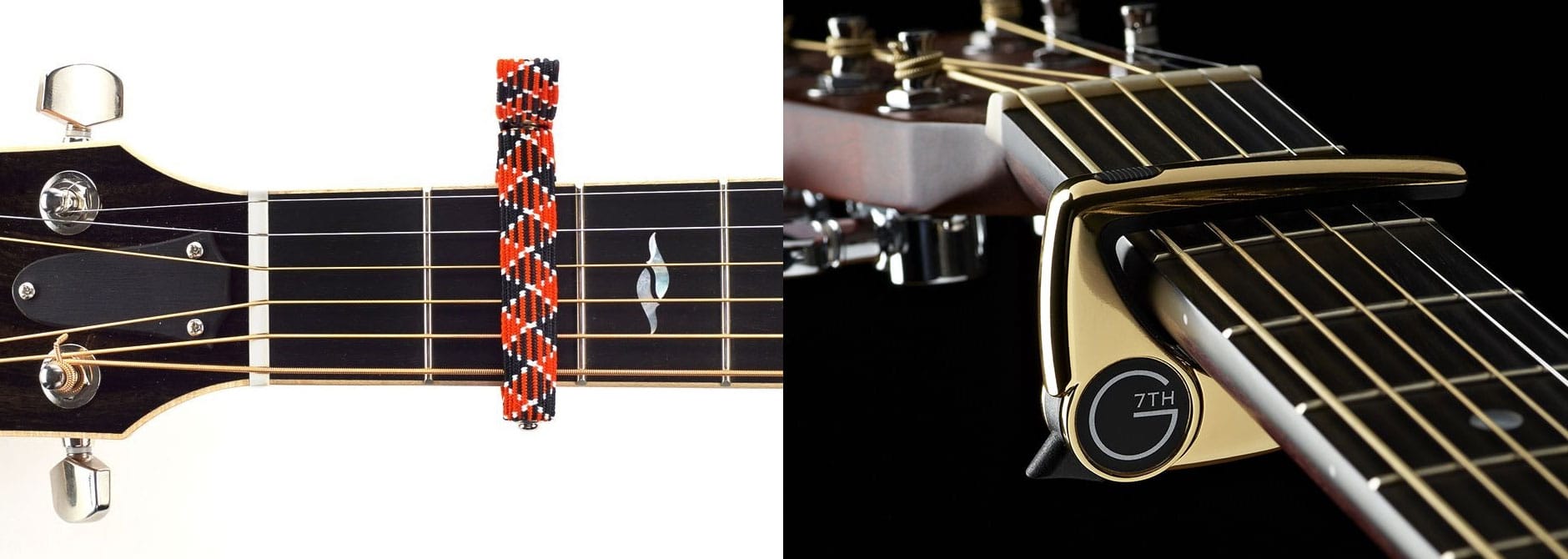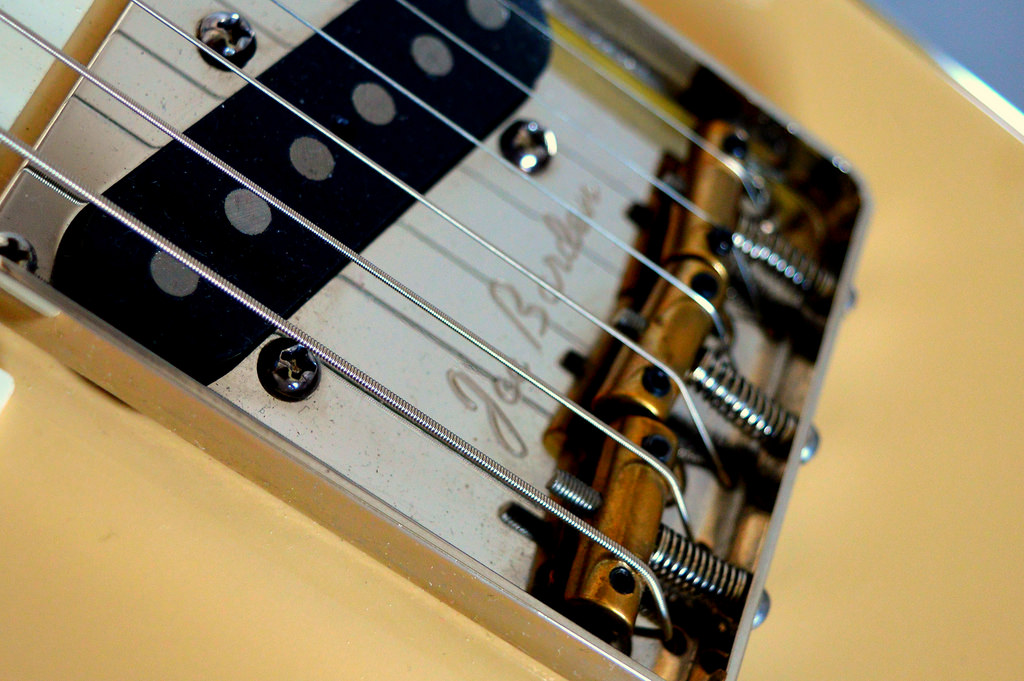- What Will I Learn?
- Why is my guitar out of tune with a capo?
- 1. Intonation
- 2. The Capo
- 3. Fret Size
- 4. Capo Placement/Bent Strings
- In Summary
There’s nothing quite as annoying as being stood on stage, having just tuned your guitar and popped your capo on and then strumming a chord only to find that your guitar is out of tune! It happens to the best of us, so don’t worry – it’s not just you.
In fact, there are a number of things it could be. So, let’s take a look at the most likely causes for your guitar’s sudden loss of tuning.
What Will I Learn?
- The 4 key reasons why a capo can throw your guitar out of tune.
- How to check your guitar’s intonation.
- The different types of capo and how they work.
- The importance of setting up a capo properly on your guitar.
Why is my guitar out of tune with a capo?
- Intonation
- Capo type
- Fret size
- Capo placement
Read on for full explanations; tick these four boxes and you’ll be strumming like there’s no tomorrow!
1. Intonation
The first thing to check is the intonation of your guitar. Put simply, a properly intonated guitar will be in tune relative to itself, across the whole fretboard. So, an ‘E’ played on the open 6th string will be perfectly in tune with an ‘E’ played on the 12th fret of the 1st string or the 5th fret of the B String.
If your guitar isn’t intonated correctly, then notes will sound progressively more out of tune the higher up the fretboard you play. This means the guitar will always sound just a little bit out. It’s worsened by using a capo, because the capo will pull all of the strings ‘slightly out’. And by playing open chords, you’ll just be making matters worse. Also, make sure you have a good capo – but more on that later.
You may not even be aware your intonation is a problem until you play your guitar with a band. Better get that soundcheck in!
How to Check Your Guitar Intonation
Guitar intonation is fairly easy to check, although not so easy to change. It’s best to get a guitar tech to adjust the intonation if you aren’t confident with guitar repairs.
But here’s a how-to guide to check it yourself. Grab your tuner of choice (mine is a Boss TU-3 Chromatic Tuner Pedal) and follow these steps for each string:
- Check the open tuning of the string and, if necessary, get it perfectly in tune.
- Now fret the same string on the 12th fret of your guitar and see if the note is still spot on.
- Play the natural harmonic found on the 12th fret by plucking the string and then quickly releasing your fretting finger. See if your tuning is still true.
You may find that your intonation is close, but not perfect. To be honest, particularly on an acoustic, with a carved one-piece saddle, you may never be able to get your guitar’s intonation perfect. But it should certainly be very close. A good rule of thumb is that, even if it’s showing as a few cents out, if it sounds in tune to your ear, then you’re going to be ok.
If there’s a large discrepancy between the tuning of your string when played open and at the 12th fret, then you’ll probably need a setup.
Keep in mind that if your guitar’s intonation is out, then anyone singing along will be singing out of tune – and that’s a bad habit to get into, especially if you are the one that’s singing!
How Do I Fix Bad Intonation?
Getting a professional to set up your guitar properly can make a world of difference. If you’re using an electric guitar, or an acoustic guitar with individually adjustable saddles, then you can correct your intonation yourself. But be warned, if you don’t really know what you’re doing it’s very easy to make a real mess of the guitar!
If your intonation is out, there’s a good chance that your guitar could benefit from a setup by a pro. They will tweak your action, check your frets are dressed properly, file the saddle (on an acoustic) and use very precise oscillating tuners to make sure your intonation is as good as it can be. If you think your guitar could benefit from a setup, check out our repairs page!
2. The Capo
OK, so let’s assume your intonation is spot on. We’re going to turn our attention to the capo itself. Capos come in all manner of shapes, sizes and price points.
There are the cheap and simple wrap around / latch style capos, which are great to chuck in a gig bag and easily adjusted to different size necks. There’s also the elasticated kind, which work in a similar principle, but with a little extra flexibility moving from guitar to guitar.
The trouble with these cheaper options is that they can bend the strings laterally when being put on or apply too much pressure to the strings due to the lack of adjustability. Excess pressure on the strings is a super common cause of tuning issues.
Essentially, the added pressure from spring loaded, elastic or cheaper capos squeezes the strings too much and pulls them out of tune. You’ll often find that the thicker strings suffer more as the capo squeezes them against the fretboard.
Test the theory: With some spring-loaded Capos, you’ll be able to test this theory – pluck a note and then just gently begin to release the tension on the capo. Not enough to cause the string to buzz, but enough to see if the pitch drops slightly as you take that pressure off.
 Different Capo Types
Different Capo Types
Which Capo Should I Buy?
There are loads of options out there that offer varying levels of adjustment. Here are some of the most popular brands:
- Shubb
- Stagg
- Fender
- Ernie Ball
- Jim Dunlop
- D’Addario
Some don’t rely on springs. which alleviates the issue of dodgy tension. For example, the G7th Performance is a great guitar capo.
The G7th allows you to apply the correct amount of pressure, ensuring that you won’t put the strings out of tune. It’s easy enough to do with one hand (just like a spring-loaded capo) and, if you do put too much pressure on the strings, you can just release the capo and find the sweet spot again.
It’s best to try a handful of capos to figure out which is best for you. You’ll want to consider budget, playing style, and ease of application.
Check out our full capo selection here!
3. Fret Size
Another potential cause might be the size of your frets. The larger your frets, the more potential you have to bend the strings out of tune as you apply pressure from the capo. This doesn’t mean you need to go and get your guitar re-fretted, but it does mean the effect of a spring capo will be greatly exaggerated.
Vintage frets (which are generally smaller) will be less affected, but jumbo frets stand quite tall, meaning there’s more distance from string to fretboard. This enhances the risk of poor tuning/intonation when more pressure is applied.
4. Capo Placement/Bent Strings
It’s also possible that you’re just putting your capo on in a hurry, at a funny angle or without applying even pressure across the strings.
Place the capo just behind the fret and check that the strings are still evenly spaced and parallel to each other. It sounds silly, but, if you’re out by the tiniest amount, you’re going to hear it.
Also bear in mind that if your strings are old, then they could be bent out of shape. Always change your strings regularly to get the most out of your guitar!
In Summary
Whilst it can be frustrating, guitar tuning issues when playing with a capo are not difficult to fix. Next time you sigh and reach for the headstock to fix your tuning, you can use this guide to work out the cause and your capo problems will be gone.
If you use a capo regularly, it is definitely worth investing in a good quality design. However, even the best capos can’t fix intonation and setup issues; so if your guitar needs some love, a good setup can do wonders to improve how the guitar sounds and feels to play.
Did you enjoy reading this article? Leave a comment below and share your thoughts!
Interested in finding out more about music gear and expanding your knowledge? Click here to view all of our Learn articles.




Responses & Questions